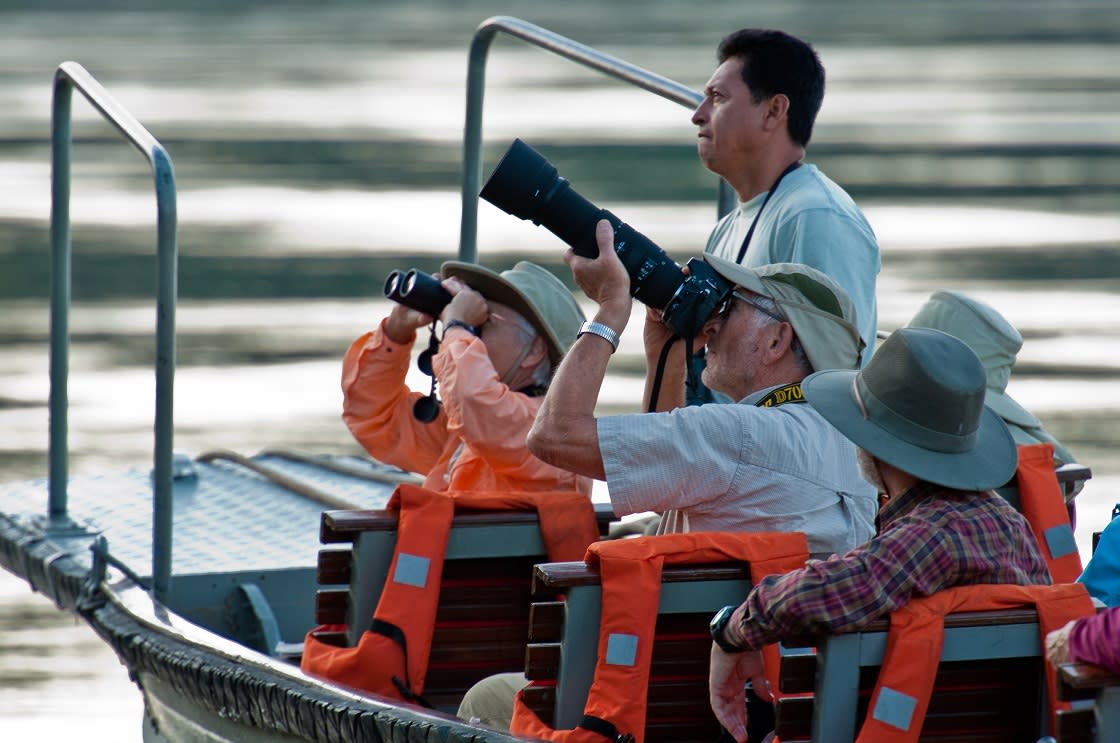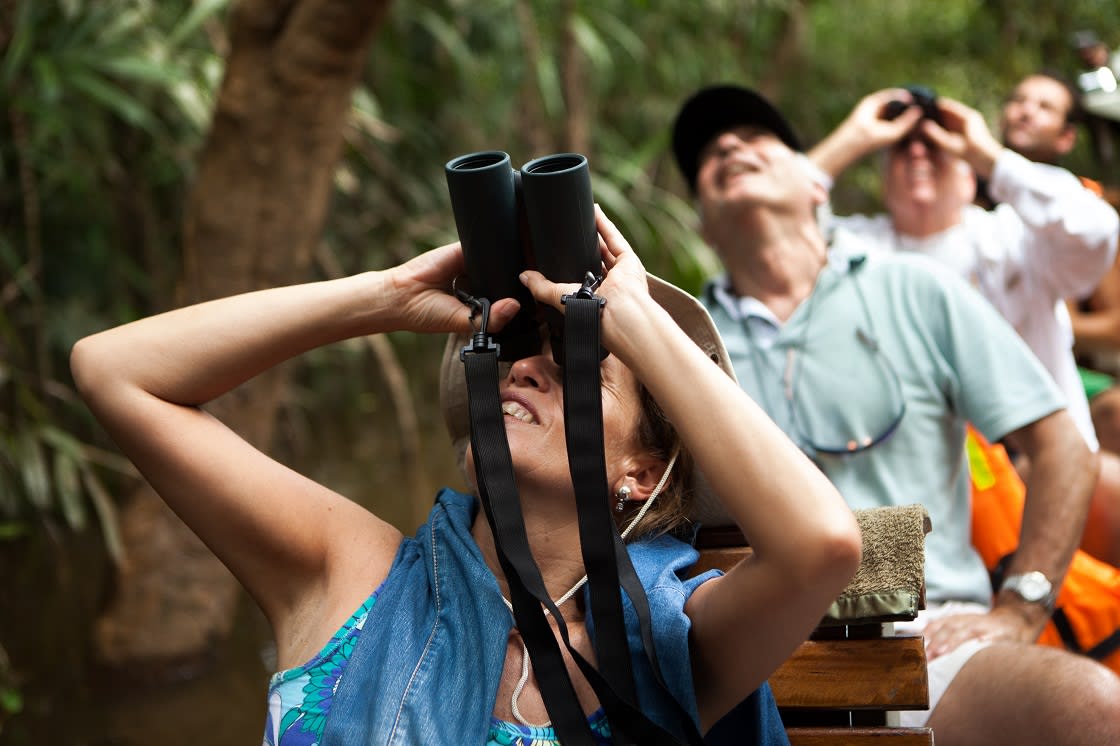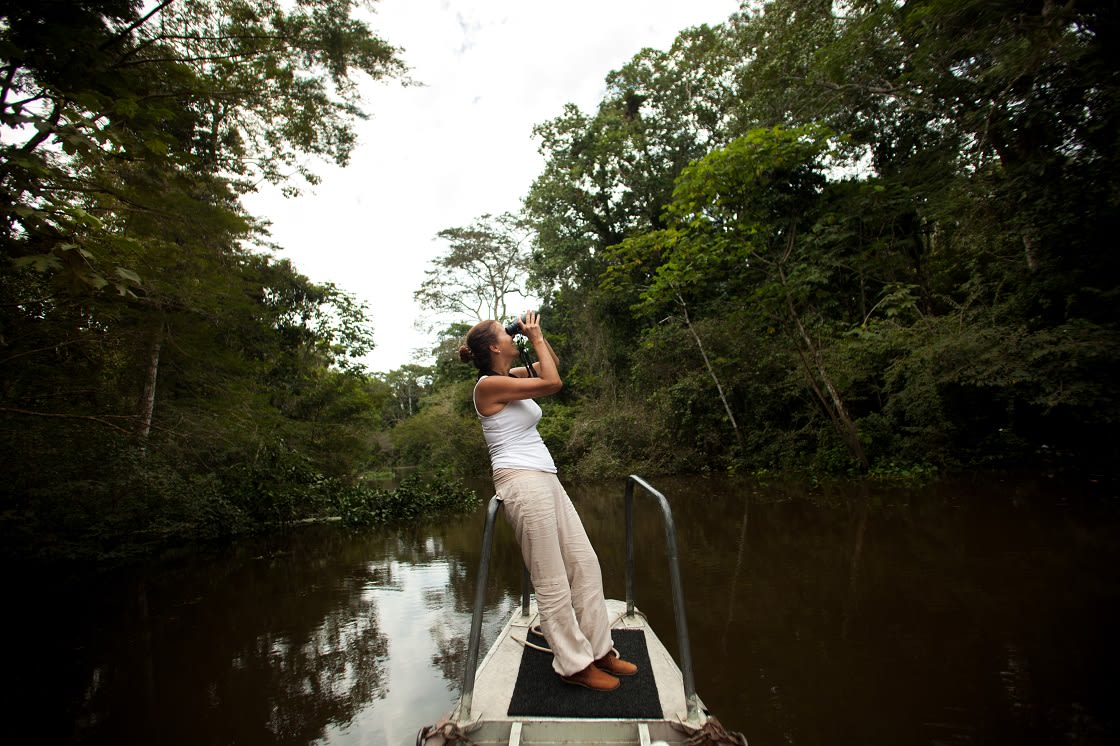
A quality pair of binoculars is an indispensable piece of kit for any Amazon river cruise. The Brazilian and Peruvian rainforests are awash with a wide range of fantastic bird specifies that require extra magnification to appreciate fully. Binoculars are also important for getting the most out of other sorts of wildlife viewing as well. Whilst you will have innumerable opportunities to trek through the jungle and approach river banks in smaller vessels, aboard the cruise boat you’ll be a little farther from the forest environment. This makes a strong pair of binoculars a great tool to have to help you appreciate all the animals, flora, birds, and marine life whilst cruising.
There are a number of different factors to consider when deciding which binoculars to bring or purchase especially for your adventurous Amazon cruise. These include lens magnification and size, weight, lens coating, waterproofing, and focusing, and will depend on your budget and specific preferences.
Below, we’ve summarized the key differences between the various types of binoculars on the market, highlighting those that are particularly suited for the Amazon, along with providing a few examples and approximate costs.

Turists Spotting Wildlife From The Skiff
When purchasing binoculars, you’ll find that each pair is specified by two sets of numbers displayed as 8×42, 7×35 or 10×50, and so on. But what do these numbers mean?
The first number refers to the lens magnification, and the higher it is the stronger the magnification, meaning that your subject will appear closer to you. So, for example, a 7 indicates that your subject will appears 7 times closer to you through the binoculars than it would through the naked eye.
In this case, it may seem logical to opt for the strongest magnification possible, especially if you’re keen on birdwatching. But there are a number of significant drawbacks to having a more powerful lens. Most importantly, a higher magnification results in a smaller field of vision, meaning you’ll get more detail but also be more restricted in how much of the wider area you can see. Another point to consider is that a stronger magnification exaggerates any shaking. In fact, binoculars over 12x magnification are generally pretty hard to hold steady and may require a tripod. In addition, more powerful binoculars produce an image that is less bright, will be heavier, and also require a little more care to focus correctly.
As a result, the recommended lens magnification for wildlife viewing in places such as the Amazon is a 7, 8, or 10, with 8x being a good compromise and a popular choice for many birders. This ensures you will have enough magnification, whilst preserving a wider field of view that will provide a more immersive experience, as well as the ability to scan and track birds and other small animals with greater ease.
The second number on the specifier refers to the objective lens diameter, measured in millimeters. Increasing the size of the binocular lens delivers more light, but also more weight and greater expense at the same time. So whilst larger lenses that let in more light and devlier a brighter image sound ideal, this needs to be weighed against considerations around budget and portability.
As a general guideline, a lens size between 30-55mm is recommended. Any higher, will mean a pair of binoculars that are significantly heavier and bulkier. Any lower than 30mm, as is usually the case in compact binoculars, will mean a loss of brightness and handling comfort. Popular lens size choices for bird watching are 40 and 42 millimeters.

Skiff Exploration
Before making your choice, here are a few more factors you may want to bear in mind.
1. Focusing
For wildlife spotting and birdwatching, in particular, it’s especially important to be able to focus fast in order to keep track of your subject as it moves around. Try to select a pair of binoculars with a focussing wheel that is easy and intuitive to use. Alternatively, you could opt for a pair of auto-focusing binoculars, such as these from Steiner, which can maintain a focus setting between 60 feet and infinity.
2. Lens Coating
This is a crucial factor determining the quality of binocular lenses. Specifically, it controls wavelengths of light which affect color perception. The best quality binoculars have lenses with multiple coatings which ensures accurate color representation, reduces glare, and delivers the clearest image all around. Meanwhile, those at the lower end have coatings that drop wavelengths which can result in color distortion.
3. Waterproofing
Most standard binoculars are reasonably water-resistant in terms of performing well in light rain or mild humidity. For the Amazon, however, we strongly recommend investing in a pair that is fully water-proof. Look for binoculars that have been completely sealed which prevents any moisture from seeping inside. You may also want to consider getting a pair that have been nitrogen purged. This will prevent fogging problems that will otherwise be ubiquitous under conditions of high humidity or rapid temperature change (e.g. between an air-conditioned boat and the hot jungle).

Adventurous Lady Spotting Wildlife From The Skiff
Our recommended pair of binoculars for an Amazon trip, and ones that are particularly suited for wildlife watching and birding, would be ones with a lens magnification of 7 or 8, such as a 7×50 or 8×42 pair. Alternatively, if you don’t mind something a bit bulkier and pricer in exchange for a little more power and detail, then you may want to consider a 10×42 or 10×50 pair. If you prefer to buy a compact pair for greater portability be sure to check that the lens size is no less than 30mm.
As is the general rule with any purchase, the more you spend the better quality product you’ll end up with. For binoculars, this means getting a superior lens coating, full water-proofing (invaluable in humid jungle conditions), and good focusing abilities (between 2.5m and infinity is ideal). These extra elements will all contribute to significantly enhance your viewing experience.
Given the great variety in binoculars, prices can vary dramatically. For a quality mid-range pair, such as the popular Nikon Monarch 5, expect to pay around $300. A decent budget pair can be obtained for around $50-70. Meanwhile, some of the best quality binoculars are significantly pricier, such as these from Swarovski SLC 8×42, which come especially recommended for birding, and come in at around $1,500.
Whilst you’ll want to bear these general guidelines in mind, selecting a pair of binoculars is ultimately a very personal decision. You’ll want to consider price and the varying importance of factors such as detail, the field of vision, the brightness of image, portability, and so on. What’s certain, is that including a pair in your Amazon packing list is pretty much essential!
While Rainforest Cruises aim to provide accurate and up-to-date information, we make no representations as to the accuracy or completeness of any information herein or found by following any link on this site. Rainforest Cruises cannot and will not accept responsibility for any omissions or inaccuracies, or for any consequences arising therefrom, including any losses, injuries, or damages resulting from the display or use of this information.




